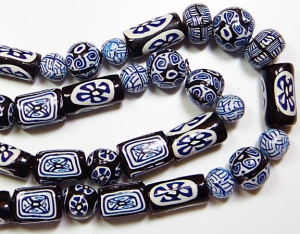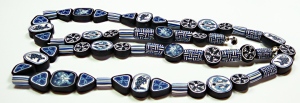The recent post on Polymer Clay Daily highlighting Joan Taylor’s lovely work in blue and white reminded me of a time when I worked in blue and white (and a little black) for about 6 months. This came about because early in my first year of caning I became frustrated with my multicolored canes looking like mud when they were reduced.
I decided to work in navy blue and white for a while so that I could focus on the designs of the cane without worrying about whether my color combinations would work. Although I used very simple canes, I was pleased with the overall designs. I made beads which I assembled into my first polymer clay necklace.
I lacquered the beads with Fimo glaze to make them look more like glass. It wasn’t too long before I realized that this didn’t really make them look more like glass, it just made them look lacquered. (Lindly Haunani shares her perspective on surface treatments for polymer in a post titled “Stop the Glop.”)
It seems that whatever I do in polymer, I tend to become obsessed with it and do it over and over. I had noticed how Japanese the first one looked and decided to study some Japanese designs and then do another.
This is my second necklace. This time I tried my hand at some animal imagery. I learned how important it was to pack the background clay tightly against the central image.
I made a third set of beads with the aim of creating more delicate designs based on a cherry blossom theme. To do this I had to create very narrow lines to delineate the petals. Here is my third necklace.
It is pretty clear that focusing on the cane designs without having to worry about the colors at the same time paid off in giving me better control of my results. If you are feeling frustrated about how your canes are turning out, you might want to give this approach a try.








Stop the Glop, I love that. I am a big fan of sanded and polished polymer.
I agree – it makes a lovely mantra, too. I love the smooth, riverstone finish of polymer that has been sanded and buffed on my jeans, but a highly buffed piece that looks like glass has its attractions too.
Apologies for replying to an old post, but it’s the most relevant. I’ve been struggling with complex kaleidoscope and mirror image canes, so yesterday, I took the idea of a monochromatic scheme from your post and focused on putting together components instead of on colour *and* components – and it worked! So thank you very much for the inspiration 🙂
I’m glad it worked for you too!
I love your work, Carol. I am Carol too! Blue is my favourite colour and I love the necklaces you’ve made. I live in Australia and am all ready to start my polymer clay hobby. Just need a push. You gave it! Thanks, Carol